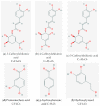The Effects and Potential Mechanism of Oil Palm Phenolics in Cardiovascular Health: A Review on Current Evidence
- PMID: 32664390
- PMCID: PMC7400923
- DOI: 10.3390/nu12072055
The Effects and Potential Mechanism of Oil Palm Phenolics in Cardiovascular Health: A Review on Current Evidence
Abstract
Cardiovascular disease (CVD) is globally known as the number one cause of death with hyperlipidemia as a strong risk factor for CVD. The initiation of drug treatment will be recommended if lifestyle modification fails. However, medicines currently used for improving cholesterol and low-density lipoprotein cholesterols (LDL-C) levels have been associated with various side effects. Thus, alternative treatment with fewer or no side effects needs to be explored. A potential agent, oil palm phenolics (OPP) recovered from the aqueous waste of oil palm milling process contains numerous water-soluble phenolic compounds. It has been postulated that OPP has shown cardioprotective effects via several mechanisms such as cholesterol biosynthesis pathway, antioxidant and anti-inflammatory properties. This review aims to summarize the current evidence explicating the actions of OPP in cardiovascular health and the mechanisms that maybe involved for the cardioprotective effects.
Keywords: cholesterol biosynthesis pathway; hyperlipidemia; oil palm phenolics.
Conflict of interest statement
The authors confirm that this article content has no conflict of interest.
Figures



References
-
- World Health Organization Cardiovascular Diseases (CVDs) [(accessed on 22 July 2019)];2017 Available online: https://www.who.int/news-room/fact-sheets/detail/cardiovascular-diseases...
-
- World Health Organization Cardiovascular Diseases (CVDs) [(accessed on 22 July 2019)];2019 Available online: https://www.who.int/health-topics/cardiovascular-diseases/
-
- Safeer R.S., Lacivita C.L. Choosing drug therapy for patients with hyperlipidemia. Am. Fam. Physician. 2000;61:3371–3382. - PubMed
Publication types
MeSH terms
Substances
Grants and funding
LinkOut - more resources
Full Text Sources

